Neanderthals, a species of humanoid thought to have gone extinct 40,000 years ago, were first discovered in the cave by American anthropologist Ralph Solecki in the 1950s. He found eight adults and two infants, some of them thought to be 65,000 years old.
Using modern scientific techniques, a team from several British universities returned to the site in Soran’s Bradost Mountain in 2014 to learn more.
The team is excited to have found a complete Neanderthal skull.
“What we have here is the skull of a Neanderthal,” said Dr Emma Pomeroy, a paleoanthropologist working at the site, pointing out the shape of teeth, jaw, and eye sockets.
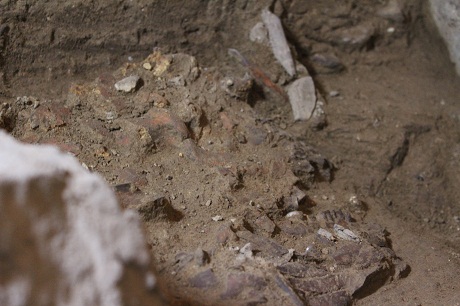 Flattened skull of an adult Neanderthal uncovered in Shanidar Cave. Eye sockets, teeth, and jaw clearly visible, September 12, 2018. Photo: Robert Edwards / Rudaw
Flattened skull of an adult Neanderthal uncovered in Shanidar Cave. Eye sockets, teeth, and jaw clearly visible, September 12, 2018. Photo: Robert Edwards / Rudaw
“It’s an adult but we don’t know yet whether it’s a man or a woman. The skull has been very crushed by all of the rocks that have been on top of it, but also the weight of the soil.”
“The teeth are quite worn, so it’s probably not a young adult. We would probably say it’s middle aged – maybe around 40, but that’s just a preliminary estimate.”
Because of the completeness of the skeletons at the site, scientists have long suspected Shanidar Cave was used by Neanderthals to bury their dead, with several academics saying the evidence points to ritual burial.
“We’ll have to wait for the detailed analysis which we’ll do once we remove the skeleton to know how old they were when they died, whether it was a man or a women, and the kind of things that may have been done to the body – whether it was buried intentionally,” Pomeroy added.
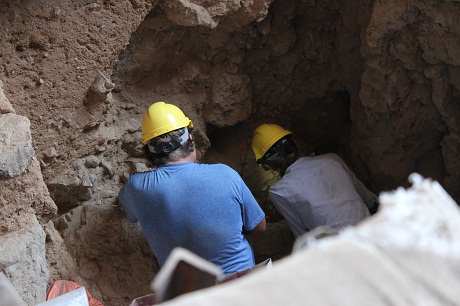 Professor Paul Bennett of Canterbury Archaeological Trust and Dr Emma Pomeroy of Liverpool John Moores University examine a Neanderthal skull found in Shanidar Cave, September 12, 2018. Photo: Robert Edwards / Rudaw
Professor Paul Bennett of Canterbury Archaeological Trust and Dr Emma Pomeroy of Liverpool John Moores University examine a Neanderthal skull found in Shanidar Cave, September 12, 2018. Photo: Robert Edwards / Rudaw
Once lifted from the soil, samples from the two skeletons will be examined alongside earlier specimens taken from Shanidar currently held by the Baghdad Museum and the Smithsonian Institution in the United States.
Solecki uncovered the remains of 10 Neanderthals when he worked at the site 60 years ago, but lacked the technology to properly preserve the specimens and test the soil around them for clues about their lives and the climate at the time.
“What’s new here in Shanidar Cave this year is that we’ve found the remains of two Neanderthals,” said Professor Chris Hunt, a sedimentologist from Liverpool John Moores University.
“We suspected they were there because Ralph Solecki, the original excavator here in the 1950s, found partial skeletons but was unable to lift everything.
“It’s good to have found them first, but second we have found the head of one of the individuals, and very few Neanderthal heads are known, so it is very good to have a new one, and particularly from this most important of Neanderthal sites.”
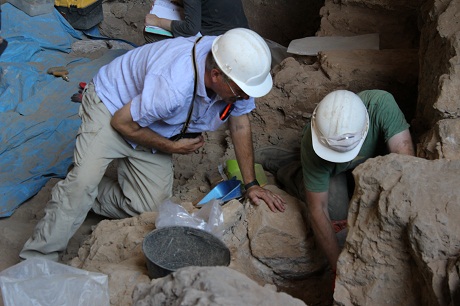 Professor Chris Hunt (L) of Liverpool John Moores University supervises excavation work in Shanidar Cave, September 12, 2018. Photo: Robert Edwards / Rudaw
Professor Chris Hunt (L) of Liverpool John Moores University supervises excavation work in Shanidar Cave, September 12, 2018. Photo: Robert Edwards / Rudaw
The team — funded by the British Academy, the University of Cambridge, and several other academic institutions — is far from finished at the site.
Work in Shanidar is complicated by extreme changes in temperature and humidity, and the team’s scientific methods are extremely expensive. One radiocarbon date costs £300 and one uranium date costs over £1,000. New funding will have to be found to continue their work.
Hunt says finding a DNA sample would be the holy grail.
“There’s many, many metres of sediments that we haven’t yet excavated, but we’re down to that level where Solecki found most of his Neanderthals,” he said.
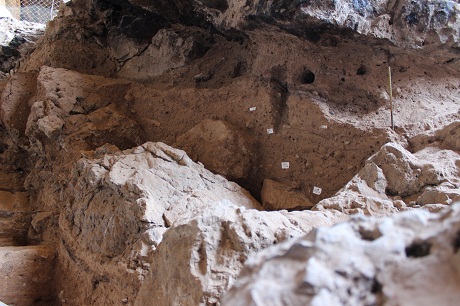 Scientists can estimate how old remains are based on the layers of sediment in Shanidar Cave, September 12, 2018. Photo: Robert Edwards / Rudaw
Scientists can estimate how old remains are based on the layers of sediment in Shanidar Cave, September 12, 2018. Photo: Robert Edwards / Rudaw
“We may find traces of one or two more. We are digging in an area where another Neanderthal was found in part about 50-55 years ago. So maybe we will find more," Hunt elaborated.
“The trouble is, if we find them, we then get into a very complicated process of conserving and lifting those remains – they’re so fragile, so easy to break, that even a bad breath is too much sometimes and it just crumbles to dust in front of your eyes, which is terribly, terribly annoying, and very worrying for science.”
Scientists from Canterbury Archaeological Trust will extract the remains from the soil after applying a layer of acetone consolidant – a much more delicate method than setting them in plaster.
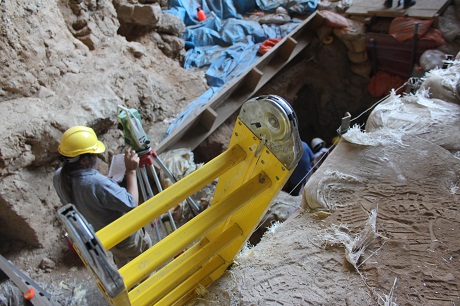 Archaeologists from Canterbury University use modern techniques to determine the age of rocks and remains in Shanidar Cave, September 12, 2018. Photo: Robert Edwards / Rudaw
Archaeologists from Canterbury University use modern techniques to determine the age of rocks and remains in Shanidar Cave, September 12, 2018. Photo: Robert Edwards / Rudaw
Scientists believe the Middle East region was a migratory meeting point where Neanderthals from present-day central Europe crossed with modern humans. Here the species are thought to have interbred. As a result, up to 4 percent of Eurasian human DNA is Neanderthal.
Shanidar Cave, today one of the Kurdistan Region’s most popular and picturesque tourist attractions, is a priceless vault of Paleolithic treasures.
“We don’t know everything yet,” Hunt cautioned. “We can guess some things and we know a few things. It appears that people were starting to use this cave – probably Neanderthal people, but we’re not sure – about 120,000 years ago, maybe a bit more. And they came back again, and again, and again, and again through time.
“We’re beginning to get the sense that they were here in the warmest times during the last Ice Age and in the warm period before that Ice Age. We think that they came here to hunt ibex – but they also ate other things like tortoises, in fact many different kinds of animals.”
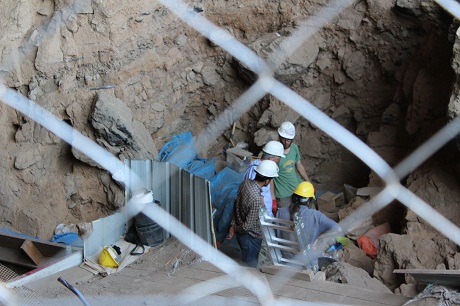 The team from several British universities will return to the site when further funding is secured, September 12, 2018. Photo: Robert Edwards / Rudaw
The team from several British universities will return to the site when further funding is secured, September 12, 2018. Photo: Robert Edwards / Rudaw
The area today is rich with wild fauna, including wolves, deer, rodents, scorpions, and camel spiders. Hunt says the presence of animal remains in the soil offers an archaeological goldmine.
“Many other animals and birds live in the cave and their remains also go into the dirt. And some of those tiny remains from things like mice actually are incredibly informative about ancient temperatures. So we’re using those as a thermometer for the Neanderthals,” said Hunt.
The team’s findings will be published in January next year.




Comments
Rudaw moderates all comments submitted on our website. We welcome comments which are relevant to the article and encourage further discussion about the issues that matter to you. We also welcome constructive criticism about Rudaw.
To be approved for publication, however, your comments must meet our community guidelines.
We will not tolerate the following: profanity, threats, personal attacks, vulgarity, abuse (such as sexism, racism, homophobia or xenophobia), or commercial or personal promotion.
Comments that do not meet our guidelines will be rejected. Comments are not edited – they are either approved or rejected.
Post a comment